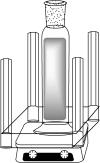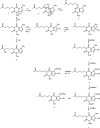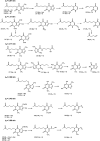Degradation kinetics and mechanism of pentoxifylline by ultraviolet activated peroxydisulfate
- PMID: 35540247
- PMCID: PMC9081778
- DOI: 10.1039/c8ra02631a
Degradation kinetics and mechanism of pentoxifylline by ultraviolet activated peroxydisulfate
Abstract
Degradation of pentoxifylline (PTX) by sodium peroxydisulfate (SPDS) assisted by UV irradiation has been investigated in deionized water. The treatment was more favorable over direct photolysis or peroxydisulfate oxidation alone. The effects of various parameters, including different dosage of oxidant agent, PTX concentration, initial solution pH levels, and the presence of inorganic ions like chloride, nitrate and carbonate have been evaluated. The rate of PTX decomposition depends on the oxidant agent dose. The highest degradation was determined at pH 10.5, which can be explained by the generation of additional hydroxyl radicals (HO˙) in the reaction between sulfate radicals and hydroxide ions. The presence of inorganic ions, especially the carbonate ions quench valuable sulfate radicals and have successfully retarded the PTX decomposition. Six PTX oxidation products were identified using UPLC-QTOF-MS for trials in a basic environment. The main degradation product (3,7-dimethyl-6-(5-oxohexyloxy)-3,7-dihydro-2H-purin-2-one) was isolated by column chromatography and identified by 1HNMR and LC MS analyzes.
This journal is © The Royal Society of Chemistry.
Conflict of interest statement
There are no conflicts to declare.
Figures











Similar articles
-
Degradation of iopromide by combined UV irradiation and peroxydisulfate.J Hazard Mater. 2010 Sep 15;181(1-3):508-13. doi: 10.1016/j.jhazmat.2010.05.043. Epub 2010 May 16. J Hazard Mater. 2010. PMID: 20561746 Free PMC article.
-
Oxidation of flumequine in aqueous solution by UV-activated peroxymonosulfate: Kinetics, water matrix effects, degradation products and reaction pathways.Chemosphere. 2019 Dec;237:124484. doi: 10.1016/j.chemosphere.2019.124484. Epub 2019 Jul 31. Chemosphere. 2019. PMID: 31394442
-
Kinetics and reaction mechanism of photochemical degradation of diclofenac by UV-activated peroxymonosulfate.RSC Adv. 2021 Feb 10;11(12):6804-6817. doi: 10.1039/d0ra10178h. eCollection 2021 Feb 4. RSC Adv. 2021. PMID: 35423182 Free PMC article.
-
Identification of photoproducts of florasulam in water using UPLC-QTOF-MS.Environ Sci Pollut Res Int. 2019 Mar;26(7):7132-7142. doi: 10.1007/s11356-019-04169-3. Epub 2019 Jan 16. Environ Sci Pollut Res Int. 2019. PMID: 30649695
-
Comparison of UV/hydrogen peroxide and UV/peroxydisulfate processes for the degradation of humic acid in the presence of halide ions.Environ Sci Pollut Res Int. 2016 Mar;23(5):4778-85. doi: 10.1007/s11356-015-5232-x. Epub 2015 Nov 5. Environ Sci Pollut Res Int. 2016. PMID: 26538259
References
-
- Ou H. s. Liu J. Ye J. s. Wang L. l. Gao N. y. Ke J. Chem. Eng. J. 2017;308:386–395. doi: 10.1016/j.cej.2016.09.076. - DOI
LinkOut - more resources
Full Text Sources

